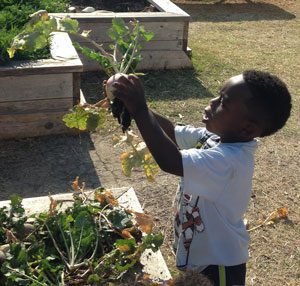 Living in persistent trauma affects every aspect of a young child’s being. Experiences like homelessness, food insecurity, domestic violence and child abuse can have a profound impact on his or her physical, emotional, social and intellectual development.
Living in persistent trauma affects every aspect of a young child’s being. Experiences like homelessness, food insecurity, domestic violence and child abuse can have a profound impact on his or her physical, emotional, social and intellectual development.
Cognitive effects associated with childhood trauma may include poor planning ability, reduced impulse control and impaired logical reasoning. When children’s lives are unstable and unpredictable, it can be difficult to develop age-appropriate levels of trust in others or in their own decision-making skills.
Physical/behavioral effects of childhood trauma may include a heightened fight, flight or freeze response; increased incidence of ADHD, motor delays, hypervigilance (enhanced sensitivity and exaggerated response to perceived threats); temper tantrums; and tactile defensiveness (negative, disproportionate response to stimuli that most people would not consider painful). If children feel insecure about their physical well-being, they may become more protective, defensive and tense, all of which can manifest in behavioral issues.
As one might imagine, the social/emotional effects of persistent trauma in early childhood can include anxiety, anger, detachment, depression, lack of empathy and difficulty cooperating and sharing. Preschoolers in trauma may lose or may never develop the ability to name, understand and feel their emotions in healthy ways. This deficit often leads to socialization and attachment challenges.
How Does Your Garden Grow?
One approach to helping children in trauma to overcome the negative impacts of their experiences consists of therapeutic gardening. Introducing preschoolers to the world of gardening allows them to be immersed in a new environment – one that is natural, beautiful and nonthreatening. Elements of a therapeutic garden may include a wildlife garden, a vegetable garden and a sensory garden.
The wildlife garden consists of plants and feeders that attract butterflies, insects and birds. Interacting with insects and animals helps preschool children to develop object permanence and anticipate the future. A wildlife garden is also a great setting for storytelling and instruction. It should include circular pathways, tunnels and bridges, the use of which improves logical reasoning. And specially placed stepping stones help reduce impulsiveness as the children have to think before making their next move.
A vegetable garden obviously provides a means for teaching preschoolers where fruits and vegetables come from and how they grow. But it also creates the opportunity to learn about key social/emotional concepts like empathy, sharing and cooperation. And low benches around the garden allow adults to sit at eye level with children, fostering attachment.
The sensory garden contains plants that create visual, auditory, olfactory and tactile stimulation. These stimuli actually reduce the high cortisol/adrenaline levels that children in trauma to engage in flight-flight-freeze behavior. Plants that grow to eye level help increase attention span, and pathways that require walking through plantings help to reduce tactile defensiveness. Additionally, the use of art, music and hands-on activities like digging and making mud pies extends the garden experience and improves motor skills.
While gardening might not immediately spring to mind as a tool for helping preschoolers in trauma, a therapeutic garden program can be a catalyst for significant intellectual, emotional and social growth.









